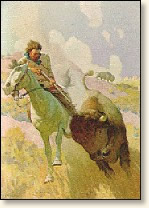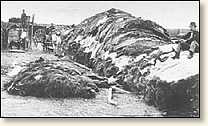|
Buffalo Hunt, 1846
Francis Parkman came to the West in the summer of 1846 having just graduated from Harvard Law School. He was twenty-three years old. His objective was to visit an Indian village in order to experience Native American culture in its original habitat. Accompanied by a cousin, Parkman spent the summer roaming the plains between the Mississippi and the Rockies, documenting what he saw. His journal was later published and launched Parkman's career as one of 19th century America's most distinguished historians.
Parkman observed a Prairie teeming with Buffalo and he took the time to note how these abundant animals were hunted:
"There are two methods commonly practiced, 'running'
and 'approaching.' The chase on horseback, which goes by the name of 'running,'
is the more violent and dashing mode of the two. Indeed, of all American wild
sports, this is the wildest. Once among the buffalo, the hunter, unless long
use has made him familiar with the situation, dashes forward in utter recklessness
and self-abandonment. He thinks of nothing, cares for nothing but the game; his
mind is stimulated to the highest pitch, yet intensely concentrated on one object.
In the midst of the flying herd, where the uproar and the dust are thickest,
it never wavers for a moment; he drops the rein and abandons his horse to his
furious career; he levels his gun, the report sounds faint amid the thunder of
the buffalo; and when his wounded enemy leaps in vain fury upon him, his heart
thrills with a feeling like the fierce delight of the battlefield.
 |
| N.C. Wyeth |
The Buffalo Hunt | A practiced and skillful hunter, well mounted, will sometimes kill five or six cows in a single chase, loading his gun again and again as his horse rushes through the tumult. An exploit like this is quite beyond the capacities of a novice. In attacking a small band of buffalo, or in separating a single animal from the herd and assailing it apart from the rest, there is less excitement and less danger. With a bold and well trained horse the hunter may ride so close to the buffalo that as they gallop side by side he may reach over and touch him with his hand; nor is there much danger in this as long as the buffalo's strength and breath continue unabated; but when he becomes tired and can no longer run at ease, when his tongue lolls out and foam flies from his jaws, then the hunter had better keep at a more respectful distance; the distressed brute may turn upon him at any instant; and especially at the moment when he fires his gun.
The wounded buffalo springs at his enemy; the horse leaps violently aside; and then the hunter has need of a tenacious seat in the saddle, for if he is thrown to the ground there is no hope for him. When he sees his attack defeated the buffalo resumes his flight, but if the shot be well directed he soon stops; for a few moments he stands still, then totters and falls heavily upon the prairie.
The chief difficulty in running buffalo, as it seems to me, is that of loading the gun or pistol at full gallop. Many hunters for convenience' sake carry three or four bullets in the, mouth; the powder is poured down the muzzle of the piece, the bullet dropped in after it, the stock struck hard upon the pommel of the saddle, and the work is done.
The danger of this method is obvious. Should the blow on the pommel fail to send the bullet home, or should the latter, in the act of aiming, start from its place and roll toward the muzzle, the gun would probably burst in discharging. Many a shattered hand and worse casualties besides have been the result of such an accident. To obviate it, some hunters make use of a ramrod, usually hung by a string from the neck, but this materially increases the difficulty of loading. The bows and arrows which the Indians use in running buffalo have many advantages over firearms, and even white men occasionally employ them.

40,000 buffalo hides displayed at
a buffalo hide yard, Dodge City 1878 |
The danger of the chase arises not so much from the onset of the wounded animal as from the nature of the ground which the hunter must ride over. The prairie does not always present a smooth, level, and uniform surface; very often it is broken with hills and hollows, intersected by ravines, and in the remoter parts studded by the stiff wild-sage bushes. The most formidable obstructions, however, are the burrows of wild animals wolves, badgers, and particularly prairie dogs, with whose holes the ground for a very great extent is frequently honey- combed. In the blindness of the chase the hunter rushes over it unconscious of danger; his horse, at full career, thrusts his leg deep into one of the burrows; the bone snaps, the rider is hurled forward to the ground and probably killed."
"The method of 'approaching,' being practiced on foot, has many advantages over that of 'running'; in the former, one neither breaks down his horse nor endangers his own life; instead of yielding to excitement he must be cool, collected, and watchful; he must understand the buffalo, observe the features of the country and the course of the wind, and be skilled, moreover, in using the rifle. The buffalo are strange animals; sometimes they are so stupid and infatuated that a man may walk up to them in full sight on the open prairie, and even shoot several of their number before the rest will think it necessary to retreat. Again at another moment they will be so shy and wary, that in order to approach them the utmost skill, experience, and judgment are necessary. Kit Carson, I believe, stands pre-eminent in running buffalo; in approaching, no man living can bear away the palm from Henry Chatillon."
References:
Parkman, Francis, The California and Oregon Trail (1849).
How To Cite This Article:
"Buffalo Hunt, 1846" EyeWitness to History, www.eyewitnesstohistory.com (2002).
|






